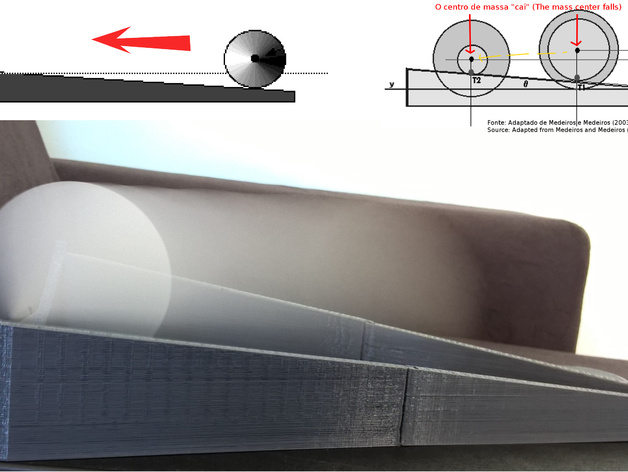
The experiment of Double Cone in the Ramp (O experimento do duplo cone no plano inclinado)
thingiverse
The experiment of the double cone on the ramp provides a counter-intuitive experience. When the double cone is placed at the beginning of the ramp, it produces an apparent climb. However, in fact, the mass center of the cones falls, while only the contact points of the cones climb the ramp. This behavior occurs because, at the beginning of the ramp, the mass center of the cones is on a higher position (higher gravitational energy) than at the end of the ramp. This experiment can be used mainly in the teaching of the center of mass concept. It is necessary to use this concept to interpret what is happening. However, it can also be used for studying torque and geometry because the relation between the object dimensions (the height of the ramp, the inclination angle, and opening angle of the ramp, the generation angle of the cone, and its radius) must be related in an appropriate way to produce the apparent climb. To build the double-cone, print two units of cones and glue them carefully so that they are properly aligned. It is recommended to use at least 30% infill in the cones. However, you can print them with different infills to compare the motion between the different masses. If it gets too light, it may not rise the ramp because the torque is insufficient to start the movement. There are two versions of this experiment: a small and a big one. The small version is suitable for printing many sets and giving them to students to explain why the double-cone rises the ramp. You can also use this version as an ornament on your table. The big version is useful for teachers to do demonstrations in front of class. Print Settings Printer Brand: RepRap Printer Model: Graber i3 Rafts: No Supports: No Resolution: 0.2 (cones and small ramp) | 0.4 (big ramp) Infill: Cones: at least 30% Notes: The ramp should be sanded to reduce the friction between the ramp and the cone. RECOMMENDATION: Print the cones one each time to avoid dripping. How I Designed This Papers used for studying the mathematics of this experiment: Desvendando o mistério do duplo cone (Uncovering the mystery of the double cone) MEDEIROS, Alexandre, and MEDEIROS, Cleide Farias de. Rev. Bras. Ensino Fís. [online]. 2003, vol.25, n.3, pp.333-339. Available from: http://www.scielo.br/scielo.php?script=sci_arttext&pid=S1806-11172003000300011&lng=en&nrm=iso RELATÓRIO FINAL: DUPLO CONE (Final report: double cone) Ceron, Sarah Vergueiro. UNIVERSIDADE ESTADUAL DE CAMPINAS INSTITUTO DE FÍSICA “GLEB WATAGHIN”. 2009. Available from: http://www.ifi.unicamp.br/~lunazzi/F530_F590_F690_F809_F895/F809/F809_sem2_2009/SarahV_David_RF1.pdf
With this file you will be able to print The experiment of Double Cone in the Ramp (O experimento do duplo cone no plano inclinado) with your 3D printer. Click on the button and save the file on your computer to work, edit or customize your design. You can also find more 3D designs for printers on The experiment of Double Cone in the Ramp (O experimento do duplo cone no plano inclinado).
